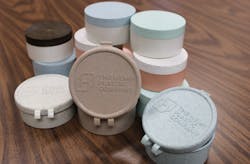Hemp Plastic aims to reduce greenhouse gas emissions, hemp waste
Hemp Plastic Co., Boulder, Colo., has been selling hemp-filled plastics since 2018.
Company executives said their goals are to reduce greenhouse gas emissions and a reliance on fossil fuels in plastics manufacturing and to find a more environmentally friendly and less expensive means of handling hemp waste.
More than 25,000 acres of hemp was grown in the U.S. in 2017, with 9,700 acres of the crop in Colorado, according to the company. Hemp is used for producing rope and fabric and to meet the growing demand for CBD oil. However, companies engaged in growing and using hemp face the problem of how to dispose of waste. As an alternative to burning it or landfilling it, Hemp Plastic compounds it with plastic resin.
The company offers a variety of products, ranging from polylactic acid (PLA), a bioplastic blended with 25 percent hemp, to traditional fossil-fuel-based plastics — including ABS, PE and PP — blended with 25 percent hemp. The company also offers an HDPE that’s made from sugarcane.
The company offers the variety to meet the needs of a wide range of processors, said Glen Kayll, CEO. Some companies want bioplastic that is commercially compostable, but others may operate in markets where commercial composting is not available or may not be able to afford the cost of a fully bio-based polymer.
While everyone is looking for a perfect solution — a biodegradable plastic that has the properties and cost of a petroleum-based plastic — that is not yet available, Kayll said. Instead, the company is offering processors a chance to take a step toward achieving their ultimate goals, he said.
“We all have an obligation, in my opinion, to do right by the planet,” Kayll said. “We’re making an awful lot of plastics right now, and it’s filling up our planet. We have to do something about it.”
While hemp-filled PLA eliminates the use of petroleum-based plastics, the company’s line of traditional resins compounded with hemp will reduce plastic use by 25 percent.
“I look at this as a migration,” Kevin Tubbs, a company co-founder, said. “Customers who have been running raw resin for decades, they need a steppingstone to get off raw resin, and that’s what Hemp Plastic provides. Maybe the first one they try isn’t 100 percent vegetable, maybe it is 20 to 25 percent, but, eventually, once they get to running it, they will see that bioplastics are indeed comparable performance-wise and easy enough to run with very slight adjustments to their gear.”
Hemp Plastic Co. works with customers to custom compound resins that are compatible with their existing equipment and have the needed mechanical properties for their applications, Kayll said.
The company is concentrating its sales on sheet producers and injection molders, Kayll said. It isn’t targeting certain products, including blow molded water bottles, because of the heat required to produce the bottles, the fact that PET is cheap and because regular PET water bottles routinely are collected in post-consumer recycling streams.
Drawbacks in some applications for hemp-filled plastics include their heat sensitivity, and, in some cases, cost.
“A lot of these bioplastics or sustainable plastics are a lot more expensive than fossil-fuel-based plastics,” Kayll said. “A lot of fossil-fuel-based plastics are based on natural gas, and natural gas is dirt cheap … It’s difficult to compete from a cost perspective.”
In many cases, though, hemp-filled plastics’ benefits, especially a reduction of carbon dioxide emissions, outweigh its drawbacks, Kayll said. In addition, compounding hemp with traditional plastics as opposed to bioplastics helps reduce the cost.
Contact:
Hemp Plastic Co., Boulder, Colo., 888-608-8472, https://hempplastic.com/
About the Author
Bruce Geiselman
Senior Staff Reporter Bruce Geiselman covers extrusion, blow molding, additive manufacturing, automation and end markets including automotive and packaging. He also writes features, including In Other Words and Problem Solved, for Plastics Machinery & Manufacturing, Plastics Recycling and The Journal of Blow Molding. He has extensive experience in daily and magazine journalism.
